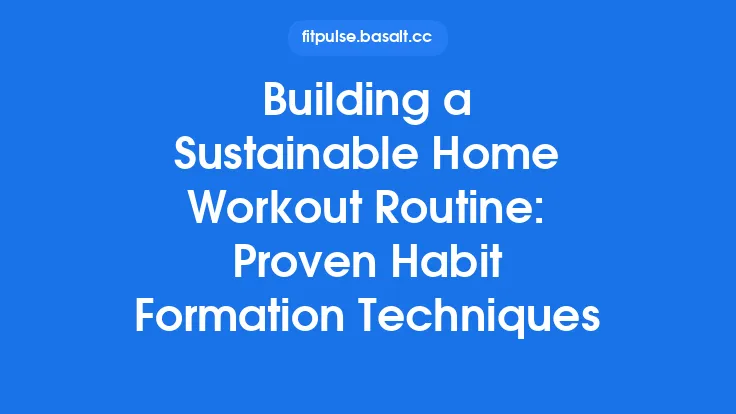The habit loop—cue, routine, reward—is the brain’s most reliable shortcut for turning a behavior into an automatic habit. In the context of a home gym, mastering this loop can turn a sporadic, “I’ll work out when I feel like it” mindset into a dependable, almost reflexive part of your day. By deliberately engineering each component of the loop, you create a self‑reinforcing system that runs on autopilot, freeing mental bandwidth for the workout itself rather than the decision to start it.
Understanding the Cue‑Routine‑Reward Triad
Cue – The trigger that tells your brain it’s time to act. It can be external (a specific time on the clock, a visual signal) or internal (a feeling of restlessness, a rise in heart rate).
Routine – The behavior you perform in response to the cue. In a home‑gym setting this is the actual workout: a set of squats, a HIIT circuit, a yoga flow, etc.
Reward – The positive outcome that your brain registers after completing the routine. It can be physiological (the endorphin rush), psychological (a sense of accomplishment), or sensory (a post‑workout smoothie).
Neuroscientifically, the cue activates a neural pathway that predicts a reward. When the reward arrives, dopamine spikes, strengthening the association between cue and routine. Repeating this cycle engrains the behavior into the basal ganglia, the brain region responsible for habit storage. The stronger the loop, the less conscious effort is required to initiate the workout.
Identifying Effective Cues in the Home Environment
- Temporal Cues
- Fixed Times: Set a specific hour (e.g., 7 am) as the “start signal.” Consistency in timing leverages the body’s circadian rhythms, making the cue more salient.
- Interval Cues: Use a timer that rings every 90 minutes to remind you to move, especially useful for those who work from a desk.
- Spatial Cues
- Designated Zones: Keep a clear, dedicated workout mat or a set of dumbbells in a visible spot. The mere sight of the equipment becomes a prompt.
- Entry/Exit Triggers: Place a resistance band on the doorframe; passing through it signals the brain that a workout is imminent.
- Sensory Cues
- Auditory: A specific playlist that starts automatically at the cue time. The first beat acts as an auditory “start button.”
- Olfactory: A scented candle or essential oil (e.g., peppermint) that you light only before training. The smell becomes linked to the upcoming activity.
- Physiological Cues
- Heart‑Rate Elevation: A quick 30‑second jumping‑jack burst can serve as a self‑generated cue, raising arousal and signaling the brain that it’s time to transition into the main routine.
When selecting cues, prioritize those that are unambiguous and consistent. Ambiguity dilutes the brain’s predictive power, weakening the loop.
Crafting Routines That Align With Your Fitness Goals
A routine should be:
- Specific: Define the exact movements, sets, and rest periods. “Do 3 × 12 goblet squats” is clearer than “work on legs.”
- Time‑Bound: Set a realistic duration (e.g., 20 minutes). Knowing the endpoint reduces perceived effort.
- Scalable: Include progression options (increase weight, add a set) so the routine can evolve without breaking the loop.
Example Routine Blueprint
| Phase | Duration | Activity | Purpose |
|---|---|---|---|
| Warm‑up | 3 min | Jump rope (moderate pace) | Elevate heart rate, prime neuromuscular system |
| Main Set | 12 min | 4 rounds: 45 s work / 15 s rest – kettlebell swing, push‑up, plank, reverse lunge | Full‑body stimulus, balanced muscle activation |
| Cool‑down | 5 min | Stretch major muscle groups + diaphragmatic breathing | Signal transition to recovery, reinforce relaxation reward |
By scripting the routine, you eliminate decision fatigue. The brain knows exactly what to do once the cue fires, reinforcing the habit loop.
Designing Rewards That Reinforce Consistency
Rewards must be immediate and meaningful to cement the loop. Delayed rewards (e.g., “I’ll lose weight later”) are less effective for habit formation.
- Physiological Rewards
- Endorphin Boost: The natural high after a workout is a powerful intrinsic reward. Amplify it by finishing with a brief, high‑intensity burst that spikes adrenaline.
- Post‑Workout Nutrition: A protein shake or a piece of fruit consumed within 10 minutes leverages the body’s recovery processes as a reward.
- Sensory Rewards
- Temperature Contrast: A quick cold shower after the session can be a refreshing, sensory payoff.
- Music Cue: Play a favorite “victory” song only after completing the routine; the brain learns to associate the song with workout completion.
- Psychological Rewards
- Self‑Affirmation: A brief mental note (“I just completed my workout”) reinforces self‑efficacy.
- Micro‑Celebration: Light a candle, open a window for fresh air, or simply sit in a comfortable chair for a minute—any small pleasure that signals success.
Avoid rewards that conflict with fitness goals (e.g., binge‑eating). The reward should complement, not undermine, the routine.
Linking Cues, Routines, and Rewards – Building a Seamless Loop
- Synchronize Timing – Align the cue’s occurrence with the moment you can immediately start the routine. If the cue is at 7 am, have your workout clothes laid out the night before.
- Create a Transition Ritual – A 30‑second bridge (e.g., “turn on the playlist, stretch arms”) smooths the shift from cue to routine, reducing friction.
- Pair Reward Immediately – As soon as the last rep is completed, trigger the reward (e.g., press “play” on the victory song). The tighter the temporal proximity, the stronger the habit reinforcement.
- Close the Loop Visually – Use a simple checklist: “Cue → Routine → Reward → ✔️”. Checking the box provides a visual confirmation that the loop completed successfully.
Using Habit Stacking to Anchor Workouts
Habit stacking involves tethering a new habit (the workout) to an already‑established habit. This leverages existing neural pathways to reinforce the cue.
Example Stack
- Existing Habit: Brewing morning coffee.
- Stacked Cue: As soon as the coffee finishes brewing, walk to the mat and start the 5‑minute warm‑up.
- Result: The coffee‑making routine becomes the trigger for the workout, embedding the loop within a daily ritual.
Select an anchor habit that is stable (rarely missed) and proximate in time or space to the workout. The more reliable the anchor, the more dependable the new habit.
Leveraging Technology to Automate Cues and Rewards
- Smart Speakers: Program a voice command (“Hey Alexa, start my workout”) that simultaneously turns on lights, plays a playlist, and announces a timer. The auditory cue and environmental change happen together, strengthening the trigger.
- Automation Apps (IFTTT, Zapier): Set a rule such as “If it’s 6 pm, then send a push notification ‘Time to train’ and dim the living‑room lights to 70%.” The app handles the cue delivery without manual effort.
- Wearable Sensors: Use a heart‑rate monitor that vibrates when your resting HR drops below a threshold, indicating readiness for activity. The vibration serves as a physiological cue.
- Reward‑Delivery Scripts: After a workout, an app can automatically order a protein shake delivery or unlock a short meditation session, ensuring the reward is delivered instantly.
Technology should simplify the loop, not add complexity. Over‑automation can dilute the sense of personal agency, so keep the system lightweight.
Adapting the Loop for Different Types of Home Workouts
| Workout Type | Ideal Cue | Routine Structure | Reward Tailoring |
|---|---|---|---|
| Strength Training | Visual cue (weights out) + time cue (e.g., 8 am) | Sets & reps with progressive overload | Post‑set protein shake + “muscle pump” feeling |
| HIIT/Cardio | Auditory cue (high‑energy playlist start) | 20 s max effort / 10 s rest intervals, 15 min total | Quick cool‑down stretch + invigorating cold splash |
| Mobility/Yoga | Olfactory cue (lavender oil) | Flow of 5‑minute sun salutations, hold each pose 30 s | Deep breathing session + calming ambient music |
| Bodyweight Circuit | Physiological cue (10 jumping jacks) | 3 rounds of push‑ups, squats, planks | Immediate hydration + sense of lightness |
By customizing each component to the workout’s nature, the habit loop remains relevant and compelling across varied training modalities.
Managing Disruptions – When the Loop Breaks
Even the most robust loops can falter due to travel, illness, or schedule changes. Strategies to recover:
- Mini‑Cue Re‑Calibration
- Replace the missed cue with a temporary one (e.g., a phone alarm) until the original cue can be reinstated.
- Reduced‑Intensity Bridge
- If the full routine feels unattainable, perform a 5‑minute “maintenance” version. Completing any portion reinforces the loop and prevents a full reset.
- Reward Adjustment
- Offer a slightly different reward (e.g., a longer stretch session) to acknowledge the altered circumstance while still providing positive reinforcement.
- Loop Audit
- Review which component failed (cue, routine, or reward). If the cue was missed, reinforce it; if the reward felt unsatisfying, replace it.
A quick “reset” within 24 hours prevents the habit from slipping into extinction.
Scaling the Loop Over Time – From Beginner to Advanced
- Cue Evolution
- Start with a high‑visibility cue (e.g., bright sticky note). As the habit solidifies, transition to a subtle cue (e.g., a specific song) to keep the loop efficient.
- Routine Progression
- Apply the “add‑one‑rep” rule: after each successful session, add a single rep or 5 seconds of work. This incremental load maintains challenge without breaking the loop.
- Reward Sophistication
- Early stages: simple sensory rewards (music). Later stages: incorporate social rewards (sharing a post‑workout selfie in a private group) or achievement rewards (unlocking a new piece of equipment).
- Loop Layering
- Once the primary loop is stable, introduce a secondary loop (e.g., a post‑workout mobility routine) that uses the completion of the first routine as its cue. This creates a cascade of habits that reinforce each other.
Scaling should be gradual; abrupt changes can destabilize the cue‑routine‑reward connection.
Common Pitfalls and How to Avoid Them
| Pitfall | Why It Undermines the Loop | Prevention |
|---|---|---|
| Overly Complex Cues | Brain struggles to recognize ambiguous triggers | Keep cues simple, singular, and consistent |
| Delayed Rewards | Dopamine response weakens, habit not reinforced | Deliver reward within 30 seconds of routine completion |
| Variable Routine Length | Uncertainty increases decision fatigue | Set a fixed duration; adjust intensity, not time |
| Reward Conflict | Reward negates fitness benefits (e.g., junk food) | Choose rewards that complement health goals |
| Neglecting the Transition | Gap between cue and routine creates friction | Use a 10‑second bridge activity to smooth the shift |
| Relying Solely on Willpower | Willpower is finite; habit loop should automate | Let cues and rewards do the heavy lifting, not conscious effort |
By proactively addressing these issues, the habit loop remains resilient and self‑sustaining.
Bringing It All Together
The cue‑routine‑reward framework offers a precise, neuroscience‑backed roadmap for turning home‑gym sessions into automatic, enjoyable parts of your day. By:
- Selecting clear, repeatable cues (time, space, sensory triggers)
- Designing concise, scalable routines that leave no room for indecision
- Pairing immediate, fitness‑aligned rewards that satisfy both body and mind
you construct a loop that the brain learns to execute without deliberation. Over time, this loop becomes a cornerstone of your daily rhythm, allowing you to focus on performance and progression rather than the mental gymnastics of “getting started.”
Implement the steps outlined above, monitor the loop’s performance, and adjust cues, routines, or rewards as needed. With consistency, the habit loop will evolve from a conscious strategy into an effortless part of your home‑training lifestyle—making every workout feel like a natural, rewarding extension of your day.





